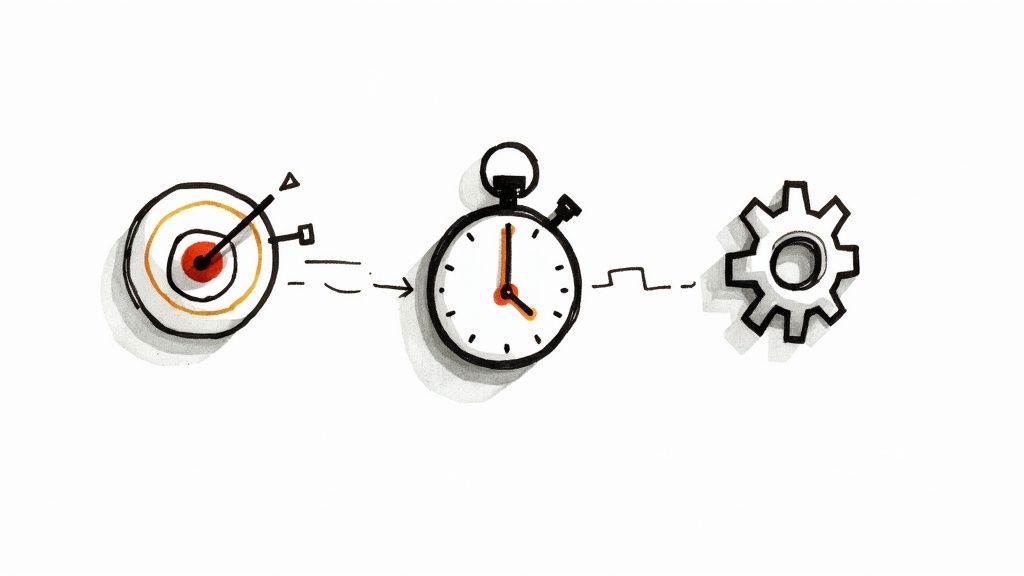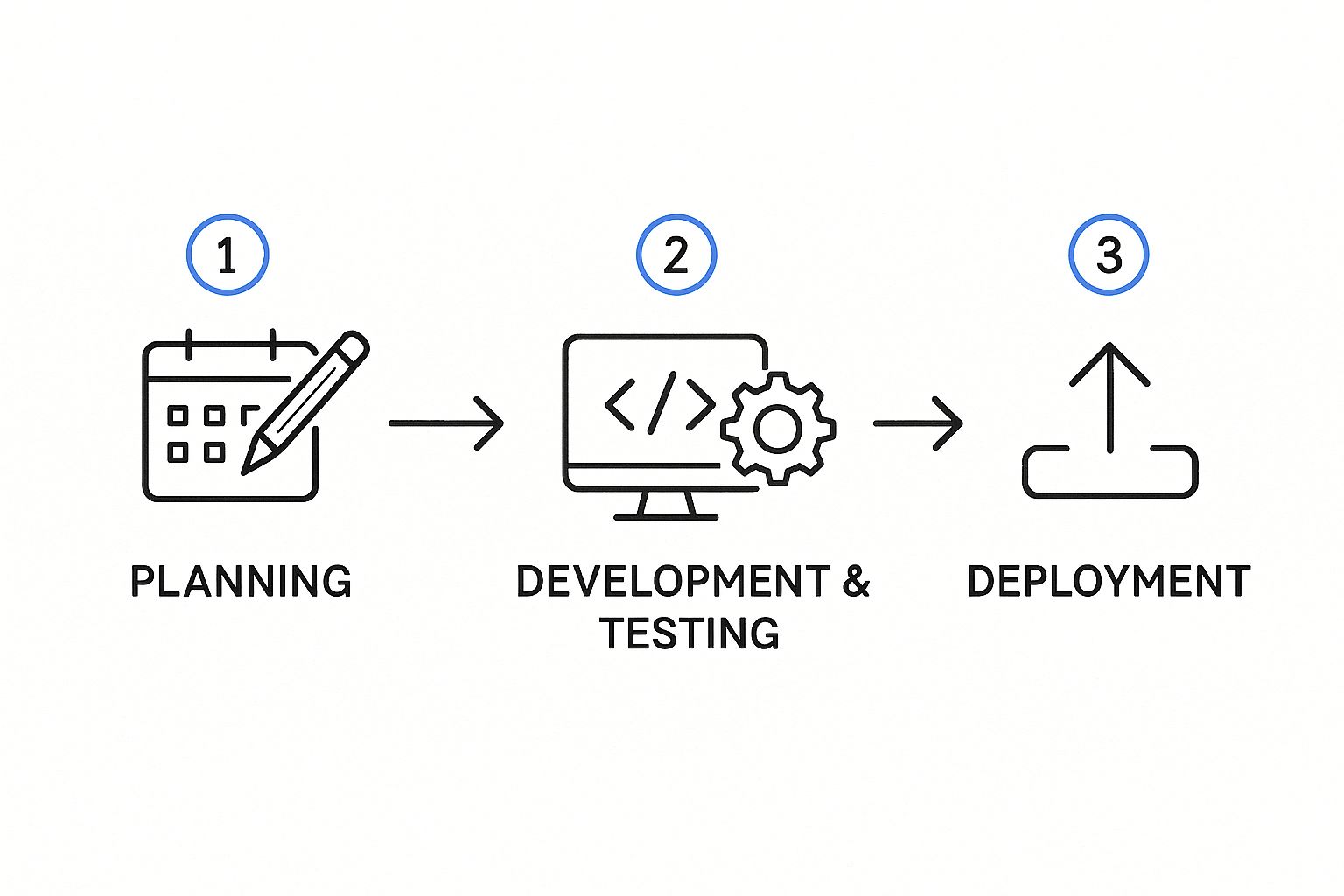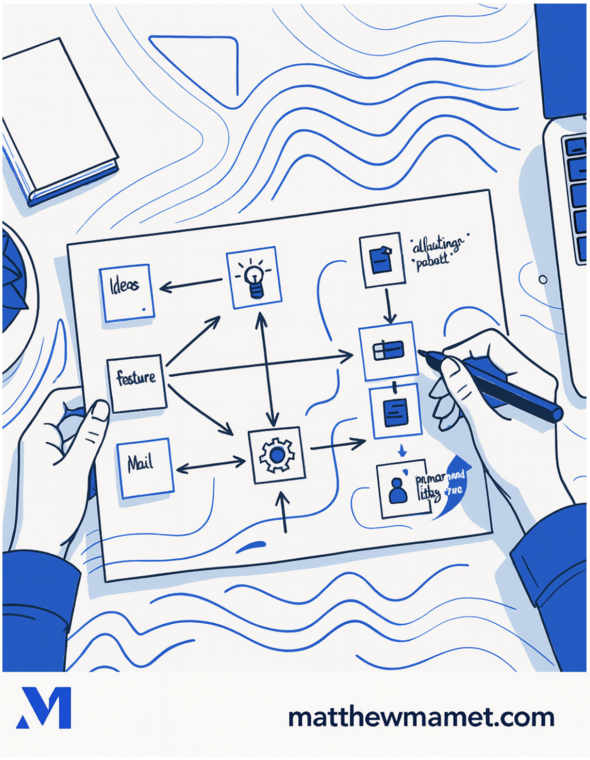Table of Contents
Let’s be honest. In the world of software, a simple checklist isn't going to save you when things go sideways on release day. A real, strategic software release plan is your best defense against the kind of chaos—unexpected downtime, feature blow-ups, and scrambled communication—that hammers revenue and torches customer trust.
Why a Release Plan Is More Than Just a Checklist
Back in the day, a simple to-do list might have been enough to get a piece of software out the door. But today’s development cycles are a different beast entirely, tangled with complex dependencies and sky-high expectations from every corner of the business.
Thinking of a release plan as just more administrative work is a rookie mistake, and a costly one. This plan is the connective tissue that gets everyone—engineering, product, marketing, support—all aimed at the same target. Without it, you’ve got teams working in silos, which is a perfect recipe for miscommunication and disaster.
Moving Beyond Reactive Checklists
A checklist is reactive. It just tells you what's already been done. A proper release plan is proactive. It forces you to think about what could go wrong, nail down who owns what, and map out a clear path forward. This is crucial in an industry where software complexity is always on the rise.
Just look at the numbers. The global software market was valued at an estimated USD 736.96 billion in 2024 and is expected to rocket to roughly USD 2.25 trillion by 2034. That explosive growth is driven by constant, complex updates, making a solid plan essential for survival.
Ready to drive more growth & achieve bigger impact?
Leverage my 25+ years of successes and failures to unlock your growth and achieve results you never thought possible.
Get StartedA robust plan forces you to ask the tough questions before you're in the hot seat: What triggers a rollback? Who’s the point person if a critical system fails? How are we telling customers about downtime? Answering these ahead of time is what separates a smooth launch from a weekend-long fire drill.
The Strategic Value of Foresight
A well-built plan does more than just lay out a schedule; it provides clarity and builds confidence across the board. It ensures every single person knows their role, the scope of the release, and exactly what success looks like. This kind of alignment cuts down on friction and lets the team focus on shipping great software, not scrambling to figure out what to do next.
Ultimately, even creative projects like writing a script underscore the fundamental need for a plan to get from an idea to a finished product. When you start treating your release plan as a strategic tool instead of a bureaucratic hurdle, you transform your entire deployment process from a source of stress into a serious competitive edge.
What Goes Into a Modern Release Plan, Anyway?

Before we jump into building a sample plan from the ground up, we need to get on the same page about what actually makes a release plan work. I've seen too many teams treat it like a simple to-do list or a calendar. A real, effective release plan is a living, strategic document. It's built from a few core pieces that all fit together.
Thinking about it this way—as interconnected building blocks—is what separates a smooth, predictable launch from a chaotic fire drill. We need to go beyond the checklist and understand the why behind each part. From nailing down the scope to having a parachute ready (your rollback plan), these components give you the clarity and structure to get it done right.
Defining a Precise Release Scope
This is where it all starts, and it's non-negotiable. You need a crystal-clear, razor-sharp definition of your release scope. This isn't just a high-level list of features. It's about drawing a firm line in the sand, spelling out exactly what's in this release and, just as crucially, what's not. This is your single best defense against scope creep, the silent killer of project timelines.
So, how do you get that clarity? You have to ask the hard questions:
- What new features are deploying? Get specific. Link out to the user stories or the requirement docs.
- Which bug fixes are included? List them out by ticket number and severity. No ambiguity.
- Any infrastructure or database changes? These are often loaded with hidden risks, so document them obsessively.
- What is explicitly out of scope? This is key for managing expectations and stopping those last-minute "can we just sneak this in?" requests.
For instance, your plan might say: "This release includes the new user dashboard (EPIC-123) and fixes for login issues (BUG-45, BUG-51). The reporting module (EPIC-124) is out of scope and will be tackled in the next release." See? No wiggle room.
Ready to drive more growth & achieve bigger impact?
Leverage my 25+ years of successes and failures to unlock your growth and achieve results you never thought possible.
Get StartedSetting Measurable and Impactful Goals
What does a "win" for this release actually look like? If you don't have concrete goals, you’re basically just pushing code into the ether and hoping for the best. A solid release plan connects the technical work to real business outcomes. These goals can't be fluffy; they have to be specific, measurable, and realistic.
Don't just say "improve performance." Aim for "cut average page load time for checkout from 3.2 seconds to under 2.0 seconds." Instead of a vague goal like "enhance user satisfaction," a much stronger goal is "reduce support tickets related to user profile management by 15% within 30 days of release."
A well-defined goal transforms the release from a technical task into a strategic initiative. It gives the entire team, from developers to marketers, a shared definition of victory and a clear way to measure their impact post-launch.
Establishing Timelines and Milestones
A realistic timeline is the spine of your release plan, holding everything together. But it can't be dictated from on high; it has to be built with real input from all the teams doing the work. Breaking the project down into clear milestones is how you make progress tangible and keep everyone pulling in the same direction.
The way your team is set up will heavily influence this. If you're curious about how different setups can impact timelines, it's worth exploring various approaches to a software development team structure.
Key milestones usually include things like:
- Code Freeze: The moment you stop adding new code (except for show-stopping bugs).
- QA Start and End: The dedicated window for the quality assurance team to do their thing.
- Staging Deployment: Pushing the code to a production-like environment for one last check.
- Go-Live Date: The big day. The scheduled time for deploying to production.
Every milestone needs a clear owner and a definition of "done." And if your release involves new integrations, make sure you're up on essential API integration best practices. A botched integration can blow up your timeline fast.
Designing a Bulletproof Rollback Strategy
Let's be real: hope isn't a strategy. Even with the best planning in the world, things can and do go wrong. A bulletproof rollback plan is your insurance policy. It's a pre-defined, step-by-step guide for reverting to the last stable version if the release hits a critical snag.
Ready to drive more growth & achieve bigger impact?
Leverage my 25+ years of successes and failures to unlock your growth and achieve results you never thought possible.
Get StartedThis isn't something you sketch out on a napkin. It needs to be detailed and, ideally, rehearsed. Your strategy must define the "red button" criteria—the specific events that trigger a rollback, like a core feature failing or a database error rate jumping over 5%. You also need to name a single person who makes the call, so there's no waffling or debate in a high-stress moment. Documenting the entire technical process, from database restoration to redeploying the old application, is what makes a swift and orderly retreat possible.
A Sample Software Release Plan You Can Steal
Theory is one thing, but seeing a real plan in action is where the rubber meets the road. Instead of giving you a dry, fill-in-the-blanks template, let's walk through a complete, battle-tested example for a fictional SaaS company.
Imagine our company, "SyncUp," is about to launch a major feature for its project management tool: The "Focus Board," a Kanban-style view for tasks. This is a big one—Version 2.5—and it’s something our customers have been clamoring for. A smooth release is absolutely critical for adoption and keeping those customers happy.
This isn't just a generic outline. It’s a tangible document you can borrow from, adapt, and make your own. We'll cover everything from the 30,000-foot view down to the nitty-gritty of deployment, who's doing what, and how we're talking about it.
 Notice how development and testing aren't separate, siloed steps. They're intertwined, which highlights just how important that constant feedback loop is before you even think about hitting the deploy button.
Notice how development and testing aren't separate, siloed steps. They're intertwined, which highlights just how important that constant feedback loop is before you even think about hitting the deploy button.
Release Overview and Goals
This first section is the TL;DR. It's the executive summary that anyone, from the CEO down to a new engineer, can scan to get the what and the why of this release in 30 seconds.
| Section | Details |
|---|---|
| Release Name | SyncUp v2.5 - Focus Board Launch |
| Release Manager | Sarah Jenkins (Product Manager) |
| Target Date | Wednesday, October 23, 2024, at 10:00 PM EST |
| Summary | This release introduces the highly anticipated "Focus Board" feature, a Kanban-style task view. It also includes performance optimizations for the main dashboard and five critical bug fixes related to user login. |
But here’s the most important part: defining what a "win" actually looks like. We need goals we can measure, tied directly to business outcomes. Otherwise, we're just shipping code into the void.
Primary Goals for SyncUp v2.5:
- Drive Adoption: Achieve 15% of active users creating their first Focus Board within 30 days of release.
- Improve Engagement: Increase average session duration for users interacting with the Focus Board by 20% compared to the standard list view.
- Reduce Support Load: Decrease support tickets related to task organization by 10% in the first quarter post-release.
Release Scope and Key Milestones
This is where we draw a very clear line in the sand. We define exactly what is—and, just as importantly, what is not—included. Getting this right is how you prevent the dreaded scope creep that kills timelines and morale.
- In-Scope Features:
- Focus Board (EPIC-412): Full implementation including drag-and-drop, column creation, and task card details.
- Dashboard Performance (TECH-118): Backend query optimization to reduce dashboard load times by at least 30%.
- Critical Bug Fixes: Includes BUG-781, BUG-785, BUG-790, BUG-792, and BUG-801, all related to multi-factor authentication flows.
- Out-of-Scope:
- Focus Board Automations (EPIC-413): Rules-based automations (e.g., "move card on status change") are slated for v2.6.
- Mobile App Integration: The Focus Board will not be available on the native mobile app in this release.
A critical part of any release plan is the timeline. It’s not just a set of dates; it’s a sequence of commitments. Each milestone needs a clear owner and a crystal-clear definition of what "done" actually means.
Ready to drive more growth & achieve bigger impact?
Leverage my 25+ years of successes and failures to unlock your growth and achieve results you never thought possible.
Get Started
Release Timeline and Key Milestones:
| Milestone | Target Date | Owner | Key Deliverable/Status |
|---|---|---|---|
| Code Freeze | Oct 9, 2024 | David Chen (Lead Dev) |
All feature branches merged to release/2.5. No new code.
|
| QA Cycle Start | Oct 9, 2024 | Maria Rodriguez (QA Lead) | Test plan executed on the staging environment. |
| UAT (User Acceptance) | Oct 16, 2024 | Sarah Jenkins (PM) | Beta user group provides feedback. |
| Final Build Ready | Oct 21, 2024 | David Chen (Lead Dev) |
Release candidate v2.5.0-rc1 is tagged and verified.
|
| Go-Live Deployment | Oct 23, 2024 | Ops Team | Deployment to production environment begins. |
| Post-Release Monitoring | Oct 23 - Oct 30 | All Teams | Hyper-care period to monitor system health and user feedback. |
Roles and Responsibilities
When things get hectic on release night, confusion over who owns what is a recipe for disaster. This section gets rid of any ambiguity by assigning clear roles. Think of it as your release-day dream team roster.
- Release Manager (Sarah Jenkins): The overall owner. She coordinates all the teams, makes the final go/no-go call, and keeps stakeholders in the loop.
- Engineering Lead (David Chen): Responsible for the technical side of the deployment, handling code merges, and leading the charge on a rollback if things go south.
- QA Lead (Maria Rodriguez): Owns the test plan, triages bugs as they come in, and gives the final sign-off on quality.
- Marketing Lead (Tom Abebe): Manages all the external noise—the blog post, email campaigns, social media updates, you name it.
- Support Lead (Emily White): Gets the support team ready with docs and canned responses, and keeps a close eye on ticket volume after launch.
To make building these plans easier over time, look into some modern document template software tools. They can help you maintain consistency without having to reinvent the wheel for every project.
Communication Plan
A smooth release lives and dies by its communication. You have to be deliberate about how you talk to two very different groups: your internal team and your external customers.
Internal Communication
- Pre-Release Briefing (Oct 22): An all-hands meeting to do a final review of the deployment steps, rollback plan, and who's on call. No surprises.
- Dedicated Slack Channel (
#release-v2.5): This is the command center. All real-time updates during deployment happen here. It's the single source of truth on release night. - Post-Release Debrief (Oct 25): A retrospective to talk about what went well, what blew up, and how we can do better next time.
External Communication
- In-App Teaser (Oct 16): A small, non-intrusive banner appears for all users, letting them know the Focus Board is "Coming Soon!"
- Blog Post & Email (Oct 24, 9:00 AM EST): The official announcement goes live, detailing the new feature and why it's awesome.
- Social Media Campaign: A coordinated push on LinkedIn and X (formerly Twitter) with a short video tutorial to show, not just tell.
Risk Assessment and Rollback Plan
This is where we embrace our inner pessimist. You have to plan for failure to guarantee success. Every single release has risks; pretending they don't exist is just asking for trouble. We identify what could go wrong and map out our escape hatch ahead of time.
Potential Risks:
- High Risk: The database migration for the new board structure fails, leading to data corruption. (This is the nightmare scenario).
- Medium Risk: The Focus Board slows to a crawl under heavy load from our big enterprise customers.
- Low Risk: A minor UI bug is found in a non-essential part of the new feature.
The rollback plan can't be a vague idea. It needs to be a clear, step-by-step procedure that everyone knows by heart.
The trigger for a rollback must be objective and decided before the release. When things are on fire, you don't want a debate club; you want a clear "if this, then that" directive.
Rollback Trigger: We will hit the big red button and roll back if any of these happen within 60 minutes of deployment:
- The critical error rate (5xx errors) jumps above 2% of total traffic.
- Core app functions like user login or main dashboard access become unavailable.
- The Focus Board is functionally broken for more than 10% of our users.
Rollback Procedure:
- Decision: Sarah Jenkins (Release Manager) makes the official "NO-GO" call in the
#release-v2.5Slack channel. - Database: The on-call DBA immediately runs the pre-tested script to revert all database schema changes.
- Application: The Ops team redeploys the previous stable version (v2.4.1) from our artifact repository.
- Verification: QA does a quick smoke test on the rolled-back production environment to confirm everything is stable.
- Communication: Sarah updates the internal status page and tells the support team to activate the "unscheduled maintenance" response for customers.
By creating a document with this level of detail, you turn your release from a hopeful gamble into a well-orchestrated operation. A plan like this gives you the structure and foresight to manage complexity and, ultimately, deliver real value to your users without all the drama.
Adapting Your Plan for Different Release Scenarios
Here's where the rubber meets the road. A rigid, one-size-fits-all release plan is a rookie mistake and a recipe for headaches. The exhaustive, detail-heavy plan you'd craft for a major version launch would be crippling overkill for a quick bug fix. Real expertise is shown in how you adapt your approach to the specific context of each release.
This flexibility is what turns a static document into a living, breathing strategic tool. Let's be honest, not every release carries the same weight or risk. A hot new feature needs a full-court press on communication and user acceptance testing, while an emergency hotfix is all about speed and stability. Get this balance wrong, and you're either burning precious time on low-impact changes or, worse, dangerously unprepared for a high-stakes deployment.
Ready to drive more growth & achieve bigger impact?
Leverage my 25+ years of successes and failures to unlock your growth and achieve results you never thought possible.
Get StartedThis isn't just a "nice-to-have" skill anymore; it's essential. The release management software market was valued at USD 1.05 billion in 2023 and is only growing, fueled by the need for tools that can keep up with frequent, complex updates. That growth in the release management market tells a story: the industry is all-in on dynamic deployment, and that means tailoring your plan is non-negotiable.
Tailoring for Release Type and Impact
The biggest dial you'll turn on your plan is the release type. Each scenario demands a different level of rigor, a different communication strategy, and a different way of looking at risk. Let's break down how your plan should morph for the common types.
- Major Version Release (e.g., v2.0 to v3.0): This is the heavyweight champion of releases. Think of it as a blockbuster movie premiere. Your plan needs to be exhaustive, covering everything from detailed marketing campaigns and full regression testing cycles to extensive stakeholder wrangling. The risk is sky-high, so your rollback strategy had better be flawless and well-rehearsed.
- Minor Feature Release (e.g., v2.1 to v2.2): This is much more targeted. Your plan can be leaner, focusing almost entirely on the new functionality. You still need to communicate, but maybe it's just in-app notifications and a blog post, not a press tour.
- Patch or Bug Fix Release (e.g., v2.2.0 to v2.2.1): Here, you're surgically addressing a specific problem. The plan should be concise, centered on verifying the fix and, critically, making sure you didn't break anything else in the process (hello, regressions). Communication is often just a quick line in the release notes.
- Emergency Hotfix: Forget the detailed plan; speed is everything. Your "plan" might just be a condensed checklist you run through in real-time. The mission is simple: identify the fix, deploy it fast, and verify stability. A crucial follow-up here is the post-mortem to figure out what went wrong and prevent it from happening again.
Adjusting for Methodology and Team Size
Your development methodology also shapes your release plan. A team using a traditional Waterfall model will probably build a massive, front-loaded plan. On the other hand, teams practicing Agile software development will have plans that are far more iterative and fluid, often evolving from one sprint to the next.
An Agile release plan is less of a static blueprint and more of a living roadmap. It focuses on delivering value incrementally, with release trains and frequent deployments, rather than a single "big bang" launch.
Team size and structure matter, too. A small, co-located team can get by with a lightweight plan and lots of informal chats. But if you're part of a large, distributed organization, you need a much more formal and detailed document to keep everyone aligned across different departments and time zones.
Think about it this way: a fintech app's release plan, no matter how small the update, must put a heavy emphasis on security audits and regulatory compliance. In contrast, a simple marketing website update might pour its resources into A/B testing user experience changes. When you get these nuances right, your release plan becomes a flexible framework for success, not a rigid prison.
Common Release Planning Mistakes to Avoid
Even with the best intentions and a solid plan in hand, things can go sideways. I’ve seen it happen more times than I can count. A seemingly perfect plan crumbles under the weight of a few common, yet devastating, mistakes.
These aren't just minor hiccups; they’re the kinds of errors that lead to blown deadlines, busted budgets, and completely burned-out teams. Avoiding them isn't about adding more bureaucracy to your plan. It’s about building a defensive mindset—anticipating where the friction will be before it becomes a full-blown crisis.
Overlooking The Small Stuff
One of the most frequent ways a release goes off the rails is by underestimating the impact of "just one more thing." A stakeholder asks for a seemingly minor tweak late in the game, but that small change often sends ripples across the entire project. It can disrupt testing schedules, introduce a swarm of new bugs, and force developers to context-switch, which absolutely kills productivity.
Your best defense here is a feature freeze. This is a hard-and-fast rule: for a set period before launch, typically one or two weeks, no new features or changes get into the build. Period. The only exceptions are for critical, show-stopping bug fixes. This creates the stability you need for final testing and keeps last-minute chaos from torching your timeline.
Ignoring Inter-Team Dependencies
Another massive blind spot is failing to map out how all the pieces connect. Your engineering team might have their part completely locked down, but what about the marketing team’s launch announcement? Or the support team's help docs? Or the crucial database schema update that another team owns?
A release is a coordinated effort across the company. Simply assuming other teams will be ready when you are is a recipe for disaster.
A simple dependency map can be a lifesaver. This visual tool forces you to identify and track every single piece of the puzzle that has to be in place for a smooth launch. It shines a bright light on potential bottlenecks long before they become emergencies.
When you can see who depends on whom, you create a shared sense of responsibility. It turns vague assumptions into confirmed handoffs and ensures all the moving parts are actually moving in sync.
Having A Vague Rollback Trigger
Lots of teams have a "rollback plan," but often it’s more of a vague idea than an actionable procedure. The single biggest mistake is failing to define the exact criteria that would trigger a rollback. Without a clear, pre-agreed-upon trigger, you'll be stuck debating the severity of an issue while the system is on fire.
This is where a real understanding of product risk management becomes essential. Your plan needs to be brutally specific.
- Define objective metrics: "Roll back if the API error rate exceeds 5% for more than 10 minutes."
- Identify critical failures: "Roll back if the checkout process fails for any user."
- Designate a decision-maker: Name the single person who has the final authority to make the go/no-go call. No committees.
In a high-stress release situation, you don’t want a debate. You want a clear, data-driven directive that strips emotion and ambiguity from the decision. When you sidestep these common blunders, your release plan stops being a simple document and becomes a powerful tool for predictable, successful launches.
Frequently Asked Questions About Release Planning
Even with the best guide and a solid template, a few practical questions always pop up. I’ve heard these from product leaders and development teams alike, so let's tackle the most common ones. Think of this as the final piece of the puzzle to clear up any lingering confusion before you dive in.
Getting your release plan right isn't just a "nice to have" anymore; it's a core business function. The demand for structured processes and tools is exploding—the global release management market was valued at USD 4.2 billion in 2023. It’s expected to more than double to USD 9.8 billion by 2032. This surge is all about the need for reliable, automated deployment pipelines. You can discover more insights about this market growth to see why nailing your planning is no longer optional.
How Is a Release Plan Different from a Test Plan?
This one comes up a lot. They're deeply connected, for sure, but they serve very different purposes and answer entirely different questions.
- A release plan is strategic. It lays out the what, when, and how for the entire deployment. It’s for everyone involved—from marketing to engineering—and covers the scope, timelines, communication strategy, and risks for the whole launch.
- A test plan is tactical. It's laser-focused on quality assurance. It details the scope, approach, and resources for all testing activities. It answers what gets tested, how it gets tested, and what "passing" actually looks like.
Here's an analogy I like: The release plan is the master blueprint for building a house. The test plan is the detailed inspection checklist used to make sure every single part of that house is up to code before you hand the keys to the new owner.
Who Should Own the Release Plan?
For any plan to succeed, someone has to own it. Clear accountability is non-negotiable.
In most teams I've worked with, either the Product Manager or a dedicated Release Manager owns the release plan. This person becomes the central hub, the conductor of the orchestra, coordinating all the moving parts between different teams.
The owner isn't the person who writes every single word. They’re the one making sure every instrument—every team—plays its part at the right time so the final performance is a success.
While your engineers will define the technical deployment steps and QA will map out testing milestones, the plan owner is the one who pulls it all together, manages communication, and ultimately makes the final go/no-go call.
How Often Should a Release Plan Be Updated?
Your release plan should be a living, breathing document. It's not a stone tablet you create once and then file away. It needs to reflect reality.
That means you update it whenever something significant changes.
Key moments for an update include:
- Scope Changes: A feature gets added, or—just as often—gets cut.
- Timeline Shifts: A critical milestone in development or testing slips.
- Risk Discovery: Someone uncovers a new potential problem that could derail the launch.
- Stakeholder Feedback: You get crucial input after a major review or from user acceptance testing.
If you're running Agile, this plan will naturally evolve from one sprint to the next. The goal is simple: the plan must always show the current state of the project. It's your single source of truth to keep everyone aligned and moving in the same direction.
A well-structured plan is a cornerstone of effective leadership. At Matthew Mamet, I work with software executives and product leaders to turn chaotic processes into predictable, high-impact results. If you're ready to refine your team's strategy and drive sustainable growth, let's connect.
Ready to drive more growth & achieve bigger impact?
Leverage my 25+ years of successes and failures to unlock your growth and achieve results you never thought possible.
Get Started



